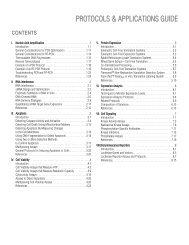2012 Promega catalogue
2012 Promega catalogue
2012 Promega catalogue
Create successful ePaper yourself
Turn your PDF publications into a flip-book with our unique Google optimized e-Paper software.
Cell Signaling<br />
ADP-Glo Max Assay<br />
Product Size Cat.# Price ($)<br />
ADP-Glo Max Assay 1,000 assays V7001 949.00<br />
For Research Use Only. Not for Use in Diagnostic Procedures.<br />
10,000 assays V7002 Pls. Enq.<br />
Description: The ADP-Glo Max Assay is a luminescent ADP detection<br />
assay that provides a universal, homogeneous, high-throughput screening<br />
method to measure ATPase or kinase activity by quantifying the amount of<br />
ADP produced in a reaction. The assay can be used to monitor the activity of<br />
virtually any ADP-generating enzyme (e.g., kinase or ATPase) when higher ATP<br />
concentration is required (up to 5mM). The ADP-Glo Max Assay produces a<br />
strong signal that positively correlates with enzyme activity and can be adapted<br />
to a multitude of plate formats.<br />
The assay is performed in two steps: first, after the completion of the ADPproducing<br />
reaction, an equal volume of ADP-Glo Reagent is added to<br />
terminate the reaction and deplete the remaining ATP. Second, the ADP-Glo<br />
Max Detection Reagent is added to simultaneously convert ADP to ATP, and the<br />
latter is converted to light in a coupled reaction with luciferase/luciferin.<br />
The ADP-Glo Max Assay has a high dynamic range and produces a strong<br />
signal at low ATP to ADP conversion, making it well suited for screening lowactivity<br />
ATPases such as drug membrane transporters and heat shock proteins.<br />
The assay produces minimal false hits and Z´ values of greater than 0.7.<br />
Several Kinase Enzyme Systems are available. Visit<br />
www.promega.com/kinase/ to see the collection.<br />
Features:<br />
• High Signal Strength at Low ATP Conversion: Users can measure<br />
enzyme activity that more closely mimics physiological conditions. This<br />
makes the assay very well suited for low-activity ATPases/kinases.<br />
• Sensitive: The assay is sensitive to low concentrations of ADP, thus requiring<br />
less enzyme than other assays; cost savings.<br />
• Universal: The assay can be used with virtually with any ADP-producing<br />
enzyme—enables researchers to screen a wider range of enzymes using a<br />
single platform.<br />
• Accommodate Wide Range of ATP Levels: The assay can be used at<br />
ATP concentrations up to 5mM, important for enzymes with high K m values<br />
for ATP and for mode of action studies.<br />
• Accurate: Accurately measures ADP levels at a wide range of starting ATP<br />
concentrations; users assured that activity measured truly reflects enzyme<br />
activity and produces accurate IC 50s comparable to radioactivity-based<br />
assays.<br />
Storage Conditions: Store the system at –20°C. Before use, thaw all components<br />
completely at room temperature. Once thawed, mix all components<br />
thoroughly before use. Because ATP is naturally prone to hydrolysis after<br />
freeze-thaw cycles dispense into single-use aliquots and store at –20°C. Once<br />
prepared, dispense, ADP-Glo Max Detection Reagent (ADP-Glo Max<br />
Detection Buffer + Substrate) into aliquots and store at –20°C. ADP-Glo Max<br />
Detection Buffer may form a precipitate when thawed. See Section 3.A of the<br />
Technical Manual for a protocol to dissolve any precipitate. For convenience,<br />
ADP-Glo Reagent and ADP-Glo Max Detection Reagent may be kept at<br />
room temperature (22°C) for 24 hours without loss of signal.<br />
Protocol Part#<br />
ADP-Glo Max Assay Technical Manual TM343<br />
Step 1: ATP Depletion<br />
Step 2: ADP Detection<br />
ATP<br />
ADP<br />
Luminescence<br />
For complete and up-to-date product information visit: www.promega.com/catalog<br />
Kinase or<br />
ATPase Reaction<br />
ADP-Glo<br />
Reagent<br />
ADP-Glo Max<br />
Detection<br />
Reagent<br />
Principle of the ADP-Glo Max Assay. The assay is performed in two<br />
steps: 1) After the ATPase or kinase reaction, ADP-Glo Reagent is<br />
added to terminate the reaction and deplete the remaining ATP; and<br />
2) the ADP-Glo Max Detection Reagent is added to convert ADP to<br />
ATP and allow the newly synthesized ATP to be measured using a<br />
luciferase/luciferin reaction. The light generated correlates to ADP present<br />
and ATPase activity.<br />
8051MB<br />
55<br />
3<br />
Cell Signaling<br />
Section<br />
Contents<br />
Table of<br />
Contents
















